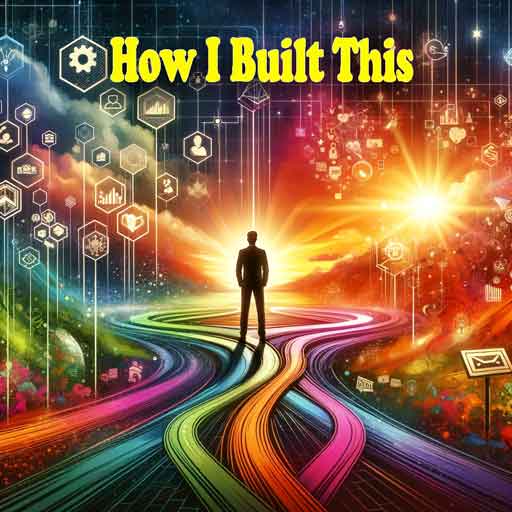
In a world brimming with tales of success and inspiration, “How I Built This: The Unexpected Paths to Success from the World’s Most Inspiring Entrepreneurs” offers a new and profound dimension to these narratives. Authored by the renowned journalist Guy Raz, this book is more than a mere compilation of success stories; it is an exploratory journey into the minds and hearts of entrepreneurs who not only achieved business success but also served as beacons of inspiration to many around the globe.
Entrepreneurial Journeys in ‘How I Built This’: Stories of Triumph and Perseverance
In “How I Built This: The Unexpected Paths to Success from the World’s Most Inspiring Entrepreneurs,” Guy Raz presents a captivating exploration of the personal and professional journeys of various entrepreneurs. Each story within this segment is a unique testament to the tenacity and spirit required to succeed in the competitive world of business.
One of the most compelling aspects of these entrepreneurial journeys is the sheer diversity in backgrounds and industries represented. From tech startups to revolutionary consumer products, Raz showcases a wide array of paths taken by these innovative individuals. Each entrepreneur’s story is not just about the destination of success but the often winding and tumultuous journey that led there.
For instance, the book delves into the story of a young entrepreneur who turned a simple idea conceived in a college dorm into a thriving global business. This journey encapsulates the challenges of securing funding, the rollercoaster of initial failures, and the relentless pursuit of a vision. Another story might explore the journey of an entrepreneur who revolutionized an entire industry by challenging the status quo, facing skepticism and resistance along the way.
What’s truly inspiring about these narratives is how each entrepreneur faced and overcame their unique set of challenges. Whether it was financial constraints, lack of support, or market unpredictability, these individuals demonstrated resilience and adaptability. Their stories are filled with moments of critical decision-making, where the right choice often meant the difference between failure and success.
Raz also highlights the personal growth that accompanies the entrepreneurial journey. Beyond the business skills and acumen developed, these stories often reveal deeper insights into self-awareness, leadership, and the importance of maintaining a balance between personal and professional life.
In summary, the ‘Entrepreneurial Journeys’ section of “How I Built This” is more than just a collection of success stories; it’s a mosaic of experiences, lessons, and insights. It offers readers a rare glimpse into the lives of those who dared to dream big and the paths they carved to turn their dreams into reality. This segment is not only informative but also immensely inspiring, making it a must-read for anyone interested in the pursuit of entrepreneurial success.
Navigating Through Challenges: Lessons from ‘How I Built This’
In “How I Built This: The Unexpected Paths to Success from the World’s Most Inspiring Entrepreneurs,” Guy Raz provides a profound exploration into the heart of overcoming challenges in the entrepreneurial journey. This segment of the book not only highlights the hurdles faced by entrepreneurs but also delves into how they triumphed over these obstacles.
One of the key aspects covered in this part is the diversity of challenges encountered by different entrepreneurs. Raz narrates stories ranging from financial constraints and market competition to personal setbacks and technological hurdles. Each story serves as a unique case study, offering insights into the multifaceted nature of challenges in the business world.
For instance, the book recounts the journey of an entrepreneur who faced significant financial challenges. This story unfolds the struggle of securing funding in a market skeptical of new ideas and how the entrepreneur’s persistence and innovative funding strategies turned the tide in their favor. It’s a tale that resonates with many startup founders who encounter similar financial roadblocks.
Another compelling narrative within the book focuses on an entrepreneur who had to navigate through technological challenges. This part of the book sheds light on how embracing innovation and adapting to emerging technologies can be a game-changer in a highly competitive market. The story highlights the importance of staying ahead in tech trends and being flexible enough to pivot strategies when necessary.
Raz also touches upon personal challenges, such as balancing work and life, managing stress, and maintaining motivation during tough times. These stories provide a more human angle to the entrepreneurial experience, showcasing that the journey is not just about business hurdles but also about personal resilience and growth.
Moreover, “Overcoming Challenges” in “How I Built This” emphasizes the learning curve that each challenge presents. Raz illustrates how facing and overcoming difficulties often leads to valuable lessons, growth, and, ultimately, a stronger business model. Entrepreneurs share their experiences of learning from failures and how these lessons propelled them to future successes.
In summary, this section of “How I Built This” serves as a testament to the spirit of perseverance and innovation in the entrepreneurial world. It provides not only a source of inspiration but also practical insights for aspiring entrepreneurs and business leaders. By showcasing real-life examples of overcoming significant hurdles, Guy Raz offers a roadmap for navigating the often tumultuous journey of building a successful enterprise.
Fostering Innovation and Creativity: Insights from ‘How I Built This’
The section on “Innovation and Creativity” in “How I Built This: The Unexpected Paths to Success from the World’s Most Inspiring Entrepreneurs” by Guy Raz is a profound exploration of the pivotal role that thinking outside the box and creative problem-solving play in entrepreneurial success. This part of the book delves into the minds of entrepreneurs who have broken the mold and redefined what is possible in their respective fields.
Raz introduces readers to a variety of innovators who have not only identified unique problems but have also approached these challenges with groundbreaking solutions. For instance, one story in the book details how an entrepreneur, facing a saturated market, successfully differentiated their product through a creative marketing strategy and innovative design, completely transforming their industry’s landscape.
Another narrative focuses on a tech entrepreneur who, through out-of-the-box thinking, developed a revolutionary technology that disrupted an entire sector. This story emphasizes the importance of embracing new technologies and being at the forefront of innovation. It highlights how a single creative idea, when executed well, can change the course of an industry.
Raz also sheds light on the process of creative problem-solving. He illustrates how some entrepreneurs went through multiple iterations of their product or business model, using feedback and failures as stepping stones to refine their ideas. This aspect of the book is particularly inspiring, showing that creativity is not a single moment of inspiration but a continuous process of improvement and adaptation.
Furthermore, this section of “How I Built This” underscores the significance of fostering a culture of innovation within a business. Entrepreneurs share their strategies for encouraging creative thinking among their teams and how this collaborative creativity has led to groundbreaking products and services.
In conclusion, the “Innovation and Creativity” section of Guy Raz’s book offers a treasure trove of insights into how innovative thinking and creative approaches to problem-solving can pave the way for extraordinary entrepreneurial success. These stories are not just about inventions but about the visionary minds behind them, emphasizing that innovation is a key driver in shaping the future of industries and the world at large.
Embracing Risk and Resilience: Key Lessons from ‘How I Built This’
In the enthralling book “How I Built This: The Unexpected Paths to Success from the World’s Most Inspiring Entrepreneurs,” author Guy Raz delves into the crucial themes of risk-taking and resilience. This section of the book is a profound exploration of how successful entrepreneurs not only embrace risk but also exhibit remarkable resilience in the face of failure.
Raz illustrates these concepts through a series of compelling narratives, each highlighting a different aspect of risk and resilience. For instance, he shares the story of an entrepreneur who ventured into an untested market with a novel product. This tale delves into the uncertainties and fears associated with pioneering in a new space, and how the entrepreneur’s willingness to take calculated risks led to groundbreaking success.
Another story in the book focuses on a founder who faced significant setbacks and failures in the early stages of their business. Raz describes the founder’s journey through these challenges, emphasizing the importance of resilience and the ability to adapt and learn from failures. This narrative is particularly inspiring, demonstrating that setbacks can be a powerful catalyst for growth and innovation.
Raz also highlights the psychological aspects of risk-taking and resilience. He explores the mindset required to navigate through uncertainty and the emotional resilience needed to bounce back from setbacks. This part of the book provides valuable insights into the mental and emotional fortitude that underpins entrepreneurial success.
Furthermore, “Risk-Taking and Resilience” in “How I Built This” underscores the lesson that taking risks is an inherent part of the entrepreneurial journey. The stories illustrate that while not all risks lead to immediate success, the willingness to take them is often what separates successful entrepreneurs from the rest.
In conclusion, this section of Guy Raz’s book offers a powerful testament to the essential role of risk-taking and resilience in building successful enterprises. It’s a treasure trove of lessons for aspiring entrepreneurs and business leaders, demonstrating that the path to success often involves embracing uncertainty and learning to thrive amidst challenges. The stories in “How I Built This” are not just tales of success; they are narratives of perseverance, adaptability, and the unyielding spirit of entrepreneurship.
Mastering Leadership and Team Building: Strategies from ‘How I Built This’
In the insightful book “How I Built This: The Unexpected Paths to Success from the World’s Most Inspiring Entrepreneurs,” author Guy Raz delves into the crucial aspects of leadership and team building. This section of the book offers a comprehensive look at the strategies successful entrepreneurs use to lead effectively and build cohesive, strong teams.
Raz highlights the importance of visionary leadership in the entrepreneurial journey. He shares stories of leaders who not only had a clear vision for their business but also possessed the ability to inspire their teams towards achieving that vision. For example, one story showcases how a leader’s clear communication of their vision and goals played a pivotal role in aligning the team’s efforts and driving the company to success.
Another significant aspect discussed is the art of assembling a strong team. Raz provides examples of entrepreneurs who excelled in identifying and recruiting individuals with the right skills and mindset to complement their business objectives. These narratives often emphasize the importance of diversity in skill sets and perspectives within a team, illustrating how a well-rounded team can bring comprehensive solutions and innovation.
The book also addresses the challenges of leadership, such as making tough decisions, managing conflicts within the team, and maintaining morale during difficult times. Raz shares insights into how successful leaders navigate these challenges while keeping the team motivated and focused on the common goal.
Moreover, “How I Built This” explores how effective leaders foster a culture of collaboration and trust within their teams. It discusses the significance of creating an environment where team members feel valued and empowered to contribute their best. This includes encouraging open communication, recognizing and celebrating achievements, and providing opportunities for professional growth.
In conclusion, the leadership and team-building section of Guy Raz’s book provides invaluable lessons for anyone looking to excel in these areas. It demonstrates that effective leadership and a strong team are not just about individual talents, but about creating a synergy that propels the entire organization forward. This part of “How I Built This” is a must-read for aspiring entrepreneurs and business leaders, offering practical strategies and real-life examples of how to cultivate a successful leadership style and build a high-performing team.
Crafting Success: Business Strategies and Execution in ‘How I Built This’
In “How I Built This: The Unexpected Paths to Success from the World’s Most Inspiring Entrepreneurs,” Guy Raz offers an in-depth examination of the unique business models and execution tactics employed by successful entrepreneurs. This section of the book is a treasure trove of insights into the strategic thinking and practical approaches that have shaped some of the most successful businesses in the world.
Raz introduces readers to a variety of innovative business models that challenge conventional wisdom. For instance, he narrates the journey of an entrepreneur who built a subscription-based service in an industry traditionally dominated by one-time purchases. This story highlights the importance of understanding market trends and customer preferences, and how adapting a business model to these insights can create new opportunities for growth and sustainability.
Another aspect the book explores is the execution of business strategies. Raz details how successful entrepreneurs not only devise innovative strategies but also excel in their execution. One compelling story in the book is about a founder who implemented a bold marketing strategy that defied the norms of their industry. This narrative showcases the significance of not just having a great idea but also the ability to execute it effectively, often requiring a mix of courage, timing, and resource management.
The book also delves into the importance of adaptability in business strategy. Raz shares stories of entrepreneurs who pivoted their business models in response to changing market conditions or unforeseen challenges. These accounts demonstrate the necessity of being flexible and responsive in business, showing that the ability to adapt can be a decisive factor in long-term success.
Furthermore, “How I Built This” explores the role of customer-centric approaches in business strategy. Raz includes examples of entrepreneurs who placed a strong emphasis on understanding and meeting customer needs, often leading to innovative product developments and enhanced customer experiences. These stories highlight the value of keeping the customer at the heart of business decision-making.
In summary, the section on Business Strategies and Execution in Guy Raz’s book provides a comprehensive look at how successful entrepreneurs think and act strategically. It offers valuable lessons on the development and implementation of business models that are not only innovative but also effective in achieving business goals. This part of the book is a must-read for aspiring entrepreneurs and business leaders seeking to understand the nuances of crafting and executing strategies that lead to enduring success.
Driving Change: Impact and Social Responsibility in ‘How I Built This’
In “How I Built This: The Unexpected Paths to Success from the World’s Most Inspiring Entrepreneurs,” Guy Raz explores the profound societal impact and ethical responsibilities that come with entrepreneurial success. This crucial section of the book delves into how entrepreneurs not only build successful businesses but also contribute to societal change and uphold ethical standards.
Raz presents various stories that illuminate how successful entrepreneurs integrate social responsibility into their business models. For example, one narrative focuses on an entrepreneur who prioritized sustainability in their product design and operations, significantly influencing their industry’s approach to environmental issues. This story underscores the power entrepreneurs have to instigate industry-wide change through responsible business practices.
Another aspect highlighted in the book is the role of entrepreneurs in community development. Raz shares inspiring accounts of business leaders who invested in community projects or initiated social programs that positively impacted the lives of many. These stories demonstrate the capacity of entrepreneurial ventures to go beyond profit-making and actively contribute to societal wellbeing.
The book also addresses the ethical challenges entrepreneurs face and how they navigate these complexities while maintaining their integrity. For instance, Raz discusses how an entrepreneur faced a moral dilemma in their business and made tough decisions that not only upheld their ethical standards but also set a precedent for others in the industry.
Moreover, “How I Built This” examines the broader implications of social responsibility for businesses. Raz explores how embracing ethical practices and focusing on social impact can enhance a company’s reputation, foster customer loyalty, and create long-term sustainability. He emphasizes that successful entrepreneurship is not just about financial gains but also about creating a positive legacy that impacts society and future generations.
In summary, the section on Impact and Social Responsibility in Guy Raz’s book is a compelling exploration of how entrepreneurs can be agents of change. It highlights the importance of integrating ethical values and social consciousness into business practices. This part of the book is an essential read for aspiring entrepreneurs and business leaders who aim to make a significant impact in their industries and communities, showing that true success encompasses both business achievement and societal contribution.
Cultivating Growth: Personal Development Insights from ‘How I Built This’
In “How I Built This: The Unexpected Paths to Success from the World’s Most Inspiring Entrepreneurs,” Guy Raz delves into the personal growth and development of entrepreneurs, offering a wealth of insights and reflections. This section of the book is dedicated to exploring the personal journeys of entrepreneurs, focusing on the experiences and lessons that have significantly contributed to their growth and success.
Raz narrates various stories that reveal how facing challenges and overcoming obstacles have been instrumental in personal development. For instance, he shares the journey of an entrepreneur who, through the trials of starting and growing a business, learned vital lessons about resilience, adaptability, and the importance of maintaining a growth mindset. This story is a powerful reminder of how entrepreneurial challenges can serve as catalysts for personal transformation.
Another key aspect highlighted in the book is the importance of continuous learning. Raz illustrates this through the story of an entrepreneur who embraced lifelong learning as a core value, constantly seeking new knowledge and skills to enhance their business and personal life. This narrative underscores the ongoing nature of personal development and the value of being a perpetual learner in the dynamic world of entrepreneurship.
The book also reflects on the significance of self-awareness and emotional intelligence in personal growth. Raz includes stories of entrepreneurs who recognized the importance of understanding their strengths and weaknesses, and how this self-awareness guided them in making better decisions, both personally and professionally. These accounts demonstrate how self-reflection and emotional intelligence are key components in the journey of personal growth.
Moreover, “How I Built This” discusses the impact of mentorship and networking on personal development. Raz shares examples of how entrepreneurs benefited from the guidance of mentors and the support of a robust professional network. These stories highlight how external influences and relationships can play a crucial role in personal and professional growth.
In conclusion, the Personal Growth and Development section in Guy Raz’s book provides invaluable insights into the transformative journeys of entrepreneurs. It highlights the significance of embracing challenges, continuous learning, self-awareness, and the power of mentorship in shaping one’s personal and professional life. This part of the book is a rich resource for anyone looking to understand the intricacies of personal development within the entrepreneurial context, offering inspiration and practical lessons for those on their own journey of growth.
Envisioning Tomorrow: The Future of Entrepreneurship in ‘How I Built This’
In “How I Built This: The Unexpected Paths to Success from the World’s Most Inspiring Entrepreneurs,” Guy Raz not only recounts the past and present of entrepreneurship but also ventures into the future landscape of this dynamic field. This part of the book offers thoughtful predictions and insights into what the future may hold for entrepreneurs and the world of business.
Raz taps into the wisdom and experiences of various successful entrepreneurs to forecast emerging trends in entrepreneurship. For instance, he discusses the increasing role of technology and digital innovation in shaping new business models. Through interviews and stories, Raz illustrates how entrepreneurs today are leveraging cutting-edge technologies like AI and blockchain to revolutionize traditional industries.
Another key focus in this section is the growing importance of social and environmental responsibility in business. Raz explores how future entrepreneurs will likely place a greater emphasis on sustainability and ethical practices. He shares stories of current entrepreneurs who are setting the trend for a more conscious approach to business, suggesting that this will become an integral part of successful entrepreneurship.
The book also delves into the changing landscape of funding and investment. Raz discusses how crowdfunding and alternative financing methods are democratizing access to capital, predicting that these will play a significant role in supporting future entrepreneurs. He also touches upon the evolving nature of venture capital and its adaptability to new business needs and global challenges.
Additionally, “How I Built This” addresses the future role of entrepreneurship in solving global issues. Raz includes insights into how entrepreneurs are increasingly viewed as key players in addressing world problems, from climate change to healthcare. This perspective indicates a shift towards entrepreneurship that not only seeks profit but also drives significant social impact.
In conclusion, the section on the Future of Entrepreneurship in Guy Raz’s book provides a forward-looking perspective on the trends and transformations shaping the world of business. It offers a glimpse into the potential changes and challenges that await future entrepreneurs and emphasizes the evolving nature of entrepreneurship as a force for innovation and societal betterment. This part of the book is a compelling read for anyone interested in understanding the trajectory of entrepreneurship and its role in shaping the future.
To Sell Is Human: Mastering the Art of Persuasion and Influence






